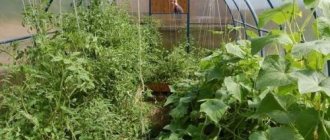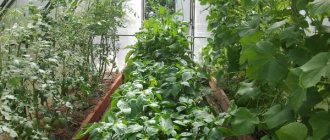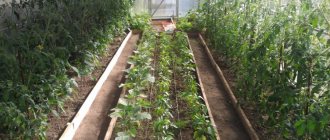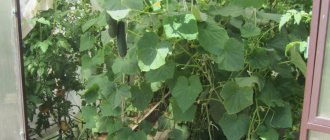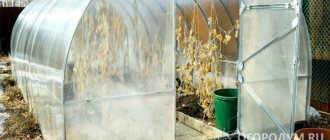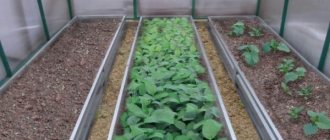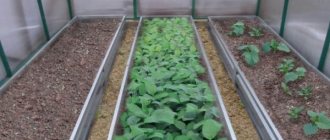A greenhouse has long become an indispensable attribute of any garden or summer cottage. It reliably covers tender early seedlings of peppers, eggplants and tomatoes until planting in a permanent place. In a greenhouse it is possible to grow several harvests of greenery and protect remontant raspberries from early autumn frosts that destroy their harvest. Any vegetable crop loved by the owners will take root in the greenhouse. But when deciding what to plant in the greenhouse along with tomatoes, it is worth considering the compatibility of the crops. Not all of them get along together.
Features of growing tomatoes in a greenhouse
Greenhouse tomatoes grown in proximity to other plants require their own microclimate. Good lighting is preferable for plants, but they also thrive in cloudy weather. The ambient temperature should be moderate and the room should be ventilated frequently. They need to be constantly fed with fertilizers and watered at the roots. Tomatoes need to be planted with plants with similar requirements.
Tomatoes vitally need fertilizers enriched with potassium and phosphorus. And excessive nitrogen content leads to the fall of the ovaries and a decrease in the amount of yield. Due to the frequent use of organic fertilizers, nitrates accumulate in fruits. Greenhouse neighbors of tomatoes should have similar requirements.
Sweet peppers in a greenhouse along with tomatoes
The correct choice of neighboring crops will help not only save space on the site, but also save energy and time for caring for plants. They will not transmit the same pests and diseases, nor will they have a depressing effect on each other. You can even arrange some semblance of symbiosis in the garden bed if you choose the right companions for the plants. It’s enough to figure out how to make a conveyor bed and what to plant next to the tomatoes in the greenhouse so that the plants feel comfortable.
On the need to observe plant interactions
How cultures coexist in natural communities is studied by the science of allelopathy. If plants are located close, they directly affect each other with the chemicals they release.
Roots contain enzymes, organic acids, phenolic compounds, vitamins and sugars. The leaves emit volatile compounds. Some substances are useful to neighbors, others are depressing.
In terms of physical impact, some plants block the sun and create shade, while others block the penetration of wind.
Indirect interaction involves the soil, which is changed by predecessor plants: enriched or depleted, compacted or loosened.
Greenhouse - into cells
What can you plant with cucumbers in a greenhouse?
To grow many types of plants in one greenhouse, it can be divided into zones using film, polycarbonate sheets, plywood or slate.
Important! In addition to the doors, at the beginning and end of the greenhouse there must be at least 2 windows located in the center.
It is equally important to choose the right material for zoning. For example, to keep the greenhouse warm in the evening, you can use sheets of dark slate, plywood or metal, since they warm up well during the day. If you need the room to be light enough, it is better to use film or polycarbonate.
What are the benefits of mixed plantings?
To create mixed plantings, it is worth determining the role for each plant. The main crop here is tomato. Accompanying plants or companion plants have the role of providing favorable conditions for tomatoes to grow better.
The bed for such plantings is made no narrower than 1 m wide. Tomato seedlings are planted along the central center line. Nearby, on one side and the other, there are shorter crops that will ripen earlier. Preferably with fibrous roots to retain moisture.
Combination option by the German gardener Hubmann:
- one row of tomatoes (center);
- three rows of beans;
- 4 rows of radishes.
What crops can coexist with tomatoes in a greenhouse?
You can grow a rich harvest by choosing the right plants that are compatible with each other. In small areas, vegetables are often planted closely. If you know perfectly how to properly organize the proximity of tomatoes and other vegetables, the plants will not transmit pests and diseases to each other, which will protect the crop from significant losses.
The neighborhood of tomatoes and other vegetables
It is worth considering the interests of not only tomatoes, but also their neighbors. For example, cabbage will be less susceptible to flea beetle attacks typical of cruciferous vegetables if its seedlings are planted next to tomatoes. Tomatoes protect turnips and onions from late blight. Experiments with the choice of varieties and planting time lead to very interesting results. Knowing the compatibility of tomatoes with other crops in a greenhouse, it is easy to choose neighbors for the plant.
It is good to plant vegetables next to seedlings of sweet peppers and eggplants. Tomatoes can be “settled” next to:
- cabbage (white, cauliflower, broccoli or kohlrabi),
- corn,
- sunflower,
- beans,
- sweet peas,
- various types of spicy herbs,
- physalis.
Tomatoes go well with melons: watermelons and melons. Pests do not attack tomatoes if parsley (curly or regular), anise, celery and mint are nearby. Marigold flowers can be planted next to the same purpose.
Advice! To save space, you can use the edges of your beds or the space between them to plant flowers and herbs.
The proximity of tomatoes and early ripening crops - onions and garlic, Chinese cabbage, radishes - is an excellent solution. Vegetables will not have to fight among themselves for nutrients, because the formation of ovaries in tomatoes will begin after the early harvest. A tomato greenhouse will become a reliable shelter for any seedlings: both vegetables and flowers. You can sow the material directly into the ground or into boxes placed on the floor or shelves.
Endive lettuce, asparagus, celery, and bush beans will get along well next to tomatoes. Chives will help repel aphids. Therefore, all these plants can be safely planted next to tomatoes.
What do they plant in the cold?
The greenhouse can be used not only in spring and summer, but also during frosts. To do this, the greenhouse must be properly insulated. And then, together with tomatoes, it is permissible to grow watermelons, strawberries, and also plant strawberries and melons. Not every gardener can share their experience of growing watermelon in a greenhouse. The fact is that melons require a special approach. Tomatoes cannot grow without adequate ventilation in the greenhouse.
Watermelon and melon, on the contrary, do not like drafts. This is the main reason why melons are grown separately from other vegetables. In general, experienced gardeners do not allow the greenhouse to stand idle for a long time out of season.
What can you grow in a greenhouse at this time of year? According to the recommendations of many amateur gardeners, you can plant vegetable seedlings in a greenhouse. With the onset of spring it can be transferred to the ground. This procedure will have a beneficial effect on the yield of main crops.
As soon as weather conditions become favorable, the seedlings can be sent to the beds, and space in the greenhouse is freed up for the main garden crops. The soil has already been prepared and cultivated, which contributes to the rapid growth of plants and a good harvest is subsequently expected.
The combination of basil and tomatoes
Basil is the best companion for tomatoes. Its proximity repels hornworms and has a positive effect on the taste of the crop. Therefore, it is worth planting basil in a greenhouse with tomatoes. It also tolerates proximity to tomatoes well. He only needs enough light and nutrition.
Tomatoes and basil
Mixed plantings with other herbs (thyme, sage, mint) are no less beneficial for tomatoes; they create protection for the garden bed from earthen pests.
Many gardeners do not know what else can be planted in a greenhouse with tomatoes. For example, to improve the quality of tomato juice and increase the shelf life of the crop, you can plant borage nearby. Among herbs, vegetables do not tolerate only proximity to lemon balm.
Good neighborhood
When choosing plants for replanting with tomatoes, it is recommended to follow these rules:
- neighbors in the garden should not belong to the same family as tomatoes (Solanaceae);
- plants must have similar requirements for watering regimes, fertilizing, and soil composition;
- compact plants should be planted that do not shade the tomato bushes.
Even when planting friendly plants in one bed, it is worth observing the recommended distance between the bushes. Otherwise, the seedlings will experience a lack of nutrition and light.
Marigolds, marigolds
Flowers not only add bright colors to the garden, but also protect plants from the invasion of harmful insects: the Colorado potato beetle, cabbage cutworm and white moth. Crushed marigold tops embedded in the soil repel root nematodes.
The disadvantage of such a neighborhood is that the flowers themselves can become breeding grounds for aphids.
Typically, marigold or calendula seedlings are used to frame tomato beds, placing the flowers at a distance of 20 cm from the tomato. Low-growing varieties of flowers are selected for joint cultivation.
Radishes, spinach and lettuce
Early maturing and compact crops are often used as a compactor in vegetable beds. Their proximity to tomatoes is very successful. During the early stages of tomato development, they require a lot of moisture, which is ideal for greens and radishes. Their lush tops, in turn, shade the bed, protecting the soil from drying out.
Disadvantage: you will have to manually weed the small seedlings of radishes and lettuce in the tomato bed.
Immediately after planting tomato seedlings, rows of radishes and herbs are sown between the rows, 15-20 cm away from the seedlings. While the tomato bushes are gaining strength, the radishes have time to form a crop and leave the garden bed.
Basil, mint and parsley
Spicy herbs overpower the smell of tomatoes with their aroma, forcing harmful insects to fly around the garden bed.
Disadvantage: Seed-sown greens grow rather slowly. For replanting in the garden, it is better to use pre-grown seedlings.
Eggplants and peppers
They have similar bush sizes and the same requirements for soil structure, watering, and fertilizing. Crops are planted in the same way as tomatoes.
Disadvantages: they have the same diseases and pests as tomatoes.
Carrots, beets
These root vegetables have a neutral effect on other plants and can coexist with tomatoes in the same bed, provided they are placed on the sunny side.
Minus: the timing of sowing carrots and planting tomato seedlings in the ground does not coincide. By the time you take the tomatoes outside, the carrots are already sprouting, so you need to plant the plants extremely carefully.
The distance between the rows of carrots and beets to the tomato bushes is 20-25 cm.
Often, extra beets are added to tomatoes after thinning.
Garlic and onion
Having a pungent aroma, garlic and onions repel many harmful insects, including spider mites. The crops have similar requirements for growing conditions and can be adjacent to tomatoes.
Cons: Plants may suffer from fusarium.
Typically, sets and slices of spring garlic are planted between tomato bushes or along the edge of the bed, 15-20 cm away from neighboring plants. Winter garlic can be sown immediately with a gap of 35-50 cm between rows to accommodate a row of tomato seedlings next spring.
Nasturtium
A beautiful flower with its aroma successfully repels whiteflies and Colorado potato beetles from vegetables (if there are not very many pests).
Minus: the flower itself may suffer from aphids.
Borage (borage)
The spicy crop, which is still not very common in domestic gardens, goes well with tomatoes in the same garden bed. The plants do not interfere with each other, and the juicy cucumber smell of borage repels harmful insects. The flowers of this plant attract bees, which will also help in pollination of tomatoes.
Cons: none.
Bush beans and Russian beans
They have a beneficial effect on the condition of the soil due to the presence of a special type of bacteria on the roots. Vegetable beans and beans have a compact bush shape and do not interfere with the development of the tomato.
Cons: Even bush plants loaded with crops sometimes fall to the ground, so it is recommended to tie them up.
What vegetables cannot be planted with tomatoes in the same greenhouse?
When growing tomatoes, it is imperative to control the temperature and humidity of the environment. That is why the correct choice of crops adjacent to tomatoes is very difficult - most vegetables do not feel comfortable next to tomatoes:
- Frequent watering and high humidity, which cucumbers love so much, are contraindicated for tomatoes;
- During growth, dill absorbs all the beneficial substances needed by tomatoes;
- young tomato seedlings will be suppressed by fennel;
- close proximity to peas is fraught with the fact that during the growth process they creep up to the tomatoes, wrap around them, and deprive them of light, so it is better to plant peas further away.
Neighborhood with some melons, such as pumpkins, squashes and zucchini, is also excluded. As they grow, they fill all available space.
Unwanted neighbors
This list includes plants that have different care requirements and growing conditions than tomatoes.
Cucumbers, zucchini and pumpkin
These crops may be good predecessors of tomatoes, but they are poor neighbors. Plants have completely different requirements for environmental conditions - tomatoes love dry air and drafts, infrequent watering, while cucumbers need high humidity. The powerful development of vines of pumpkin plants deprives tomato bushes of space.
Potato
It belongs to the same family as tomatoes, and therefore has common diseases and pests. The main ones are late blight and the Colorado potato beetle. If a potato plot is allowed to be treated with powerful pesticides, then such preparations cannot be used for tomatoes.
It is not recommended to plant these crops not only in one bed, but also in neighboring ones. The Colorado potato beetle easily crawls from treated potato plants to tomato plants, covering a distance of 10-15 m.
Sorrel
The culture prefers acidic soil and has a depressing effect on neighbors. It is better to plant sorrel in a separate bed or combine it with rhubarb.
Watermelon
It requires a large space for the growth of vines and dry sandy soil, which does not at all meet the requirements of a tomato for living conditions.
Cabbage (all types)
Loves frequent watering and humid air, which is completely unsuitable for tomatoes. Although ultra-early ripening varieties of the white cabbage variety can be placed at the edge of the bed with late tomatoes, so that when watering with sprinkling, the tomato leaves do not get wet. Until the fruits on the tomato bushes begin to turn red, caring for the crops does not differ much. By the time the late tomatoes ripen, the cabbage will have time to form heads and leave the garden bed.
The smell of tomato tops repels cabbage flies and cutworms, helping to produce clean heads of cabbage.
Corn
It consumes a lot of nutrients from the soil, significantly depleting it. Planted mixed with tomato bushes, it shades the latter.
Corn planted at a distance of 50-60 cm from the tomato rows can become a good curtain against strong winds.
Peas
A tomato-neutral culture. But peas, even bush peas, take up a lot of space in the garden bed, often lie on the ground, and cling to tomato branches with their tendrils, preventing it from functioning normally. If you put small trellises for it, letting the tendrils curl along them, then growing crops together is possible.
Strawberries
Garden strawberries (strawberries) suffer from the same diseases as tomatoes, so growing these plants together in the same bed is not practiced.
Dill
There is no point in specifically sowing dill in a tomato bed; the crops are not friendly with each other. But early seedlings from self-seeding need not be weeded out until they reach a height of 10 cm. Until this moment, dill will not interfere with tomato seedlings, and then the greens are removed.
Cucumbers and tomatoes in one greenhouse
If there is a critical lack of space on the plot, cucumbers and tomatoes can be planted side by side, but this will significantly affect the quality and quantity of the harvest, not for the better.
Cucumbers and tomatoes are such popular vegetables that it is impossible to imagine the human diet without them. Summer residents grow them not only for fresh consumption, but also stock up for the winter by canning them. These vegetables are mainly grown in greenhouse conditions. If they are cultivated for sale in large quantities, it is necessary to make a separate shelter for each. Amateur gardeners often grow cucumbers and tomatoes in the same room.
Important! This option is quite possible provided that the microclimate of the greenhouse is adapted to each vegetable, because they have completely different requirements for ventilation, temperature and humidity of the environment.
Cucumbers prefer a humid, warm climate and do not tolerate direct sunlight on their surface. They need to be watered by sprinkling, which is strictly contraindicated for tomatoes.
On a note. It is necessary to organize the placement of these plants in such a way that they are at a sufficient distance from each other.
If the length of the greenhouse allows, it can be delimited inside with polycarbonate, plywood or boards. In this case, you have to make exits from the greenhouse on both sides. Then airing the tomatoes will in no way harm the cucumbers. In turn, the tomatoes will not suffer from excess moisture when watering the cucumbers.
The list of vegetables given in the article is not complete. It contains the most popular and well-known vegetables that can be grown by both experienced gardeners and gardeners, as well as amateur beginners.
1 1 vote
Article rating
Characteristics of culture
Tomatoes belong to the nightshade family. They were brought from the country of South America. They are found there as a wild plant. In our country, tomatoes are classified as the main crops. Water them rarely, but with plenty of water.
Humidity is harmful to them. They are susceptible to various fungal diseases. Light is as important for them as a sufficient amount of fresh air. When there is insufficient lighting, the plants become very elongated, the leaves dry out and become lighter in color. Let's look at what can be planted with tomatoes.
cucumbers
This is an extremely unfortunate neighborhood option. For normal development, tomatoes require constant ventilation of the greenhouse, but cucumbers do not need it.
The air temperature for fruiting tomatoes is 23-25 degrees. Cucumbers require +20…+22 °C for this. At a temperature of +30 °C, tomatoes will not bear fruit.
Cucumbers require high air humidity, up to 100%. With a lack of moisture, the leaves of the bushes wither and flowering slows down. Such humidity is detrimental for tomatoes - they begin to hurt when the 65% mark is exceeded.
Thus, cucumbers and tomatoes require opposite growing conditions. A common problem in such a greenhouse is late blight. The disease appears due to the abundance of moisture for cucumbers and the through ventilation that tomatoes love.
Making the right choice
Choosing the right garden neighbors is a real art. The plant community must be composed in such a way that it represents an autonomous structure, where each crop will play its role, bringing a certain benefit.
Some species enrich and loosen the soil, others repel pests, and others accelerate the ripening of neighboring fruits.
The planting structure should look like this:
- the bed must be at least 1 m wide;
- tomato is the main crop and is planted in the center of the bed;
- Companion plants are planted on the sides of the designated area. These should be low-growing plants with a rapid ripening period in order to have time to collect them by the time the main crop ripens (onions, radishes, parsley);
- As accompanying crops, it is best to use plants with fibrous root systems, which help retain moisture in the soil longer and species that repel pests (garlic).
Tomatoes work well with spinach, chives, bush beans and endive. It is good to plant them around the perimeter of the garden bed.
There are many examples of joint plantings. One of the most famous combinations, created by the German gardener Hubmann, is tomatoes (1 row in the center of the bed) combined with beans (3 rows) and radishes (4 rows).
Each vegetable has its own “apartment”
For those who are still trying to grow poorly compatible vegetables in one greenhouse, there is a way out. This is the organization of space . What can you use to plant tomatoes in a greenhouse? The most “greenhouse” plants are tomatoes, cucumbers, peppers and eggplants. Their compatibility leaves much to be desired, so they should be separated from each other .
If the greenhouse has two entrances on opposite sides , it is easier to place crops in it. If it is wide enough, three beds are made. Tomatoes are planted in the middle - this part of the greenhouse is best ventilated. Peppers are placed on the north side, cucumbers or eggplants are placed on the south bed. Although it is better to exclude cucumbers .
If there is one door in the greenhouse , and only a window on the opposite side, the crops can be arranged in the following order: tomatoes are planted near the doors, they should be separated from the rest of the area either by film, or by slate or plywood. The best material is film.
Next, cucumbers are planted, followed by eggplants - both vegetables are very heat-loving and will do well in the middle. And last but not least, peppers are planted near the window; they prefer a cooler atmosphere.
When placing crops that are not very compatible in one greenhouse, you must be prepared for a slight decrease in the yield of each crop.
Today, greenhouse manufacturers offer various designs, in particular internal ones. Using partition modules, you can create separate rooms with the desired microclimate in them, which will allow you to combine “incompatible things” in one greenhouse and not have to think about what to plant tomatoes with.
Neighbors in the greenhouse must be selected based on the required growing conditions
The greenhouse allows you to harvest any crop at a time that can be characterized in relation to this vegetable by the definition of “off season”. Therefore, home-grown greenhouse owners try to “fit” the largest number of different types of vegetables into them. Peppers, radishes, onions or cucumbers are traditionally added to tomatoes, but not all of these vegetables are compatible with the crops.
During cultivation, each vegetable crop has “its own” requirements regarding:
- air temperature;
- soil moisture level;
- degree of greenhouse ventilation;
- type and amount of fertilizing required.
If you place vegetables with diametrically different growing parameters nearby, then oppression of one or another crop will occur. Tomatoes are very capricious in terms of compatibility with other “residents” of the greenhouse, because they are the dominant crop in the garden. You can also read the article about the temperature regime for tomato seedlings.
Cabbage
Such a neighborhood will benefit both plants. The smell of tomatoes will repel cabbage butterflies from the beds. This means that the vegetables will remain intact and the crop will not be damaged by pests.
Early varieties of cabbage should be planted so that there is about one and a half meters from one row to another. Later, tomato bushes can be placed between the cabbage plantings.
Compatibility of tomatoes with the most popular vegetables
Most often, gardeners try to place tomatoes in the same greenhouse with the crops most in demand in our diet: cucumbers, peppers or eggplants. But the compatibility of these ligaments does not always exist. Thus, cucumbers and tomatoes can be grown together in a greenhouse only if their growth zones are demarcated.
Tomatoes and cucumbers
Tomatoes require root watering, good ventilation, mandatory application of fertilizers and fairly moderate temperature conditions. Cucumbers also need to be watered by sprinkling. They do not like drafts, do not need vitamin supplements other than organic fertilizers, and they need heat. Such different care requirements show that growing cucumbers and tomatoes in the same greenhouse requires different approaches.
To prevent these antagonists from interfering with each other, before planting cucumbers and tomatoes in the greenhouse, you need to divide the room into two parts with a partition. If there is only one entrance to the greenhouse, then it is possible to organize the delimitation of zones with a film curtain. The following zoning is also used: beds with tomatoes are placed on one edge of the greenhouse, beds with cucumbers on the other, and peppers or eggplants are planted in the middle of the greenhouse.
Tomatoes and peppers
Being relatives of the nightshade family, tomatoes and peppers get along very well in the same greenhouse. Moreover, the presence of tomato bushes nearby protects the pepper from damage by aphids.
Tomatoes and eggplants
But growing tomatoes and eggplants in the same greenhouse requires taking into account the differences inherent in these two crops in their maintenance.
Tomatoes need less light and water than eggplants. Therefore, their cultivation, as well as the joint cultivation of cucumbers and tomatoes in a greenhouse, requires delimitation of space and the creation in these zones of the climatic conditions necessary for each crop. See the article: Fertilizers for tomato and pepper seedlings.
Publication date: Cultivation
Plant placement methods
If necessary, you can plant tomatoes along with other crops. Whether or not to plant incompatible vegetables in a greenhouse is everyone’s business, but there is a way out. Experienced gardeners suggest rationally using the entire area of the greenhouse and using the correct planting organization. With a rational approach, you can not only not harm the growth of the crop, but also increase it by 30%.
There are several ways to accommodate incompatible plants in a greenhouse. The design of the greenhouse itself plays an important role here. If it has two entrances and there is enough space for planting vegetables, then 3 beds are dug up first. Tomatoes are planted in the central bed, since this part is the most ventilated.
Cucumbers are located in the southern part of the greenhouse, and eggplants are located on the northern side. Even with this approach, experts do not recommend planting cucumbers together with tomatoes. This is due to the fact that the care when growing them is completely different.
If the greenhouse has one door and a window, then the layout of the planting material is as follows: tomatoes are placed opposite the door, and they are separated from other plants using film. You can also use sheets of plywood or slate.
Most gardeners who use this method of planting prefer film. Cucumbers are planted behind the tomatoes, followed by eggplants. That is, the most heat-loving and draft-resistant vegetables are located in the center. It is preferable to plant peppers under the window. This culture loves cool weather.
You can plant all these crops together in a greenhouse if there is a need for this, but in this case you need to be prepared for the fact that the yield will drop slightly, but still. Considering that the problem of compatibility of various vegetable crops is known to many gardening enthusiasts, greenhouse manufacturers began to produce designs with various internal modifications.
When installing them on the site, internal partitions and ceilings are installed. With their help, you can design separate “rooms” for planting plants at your discretion. At the same time, each individual room will have its own microclimate, which will give many gardeners the opportunity to grow different vegetable crops at the same time, combine incompatible things and get a full harvest. And then there will be no dilemma about what to plant with tomatoes.
